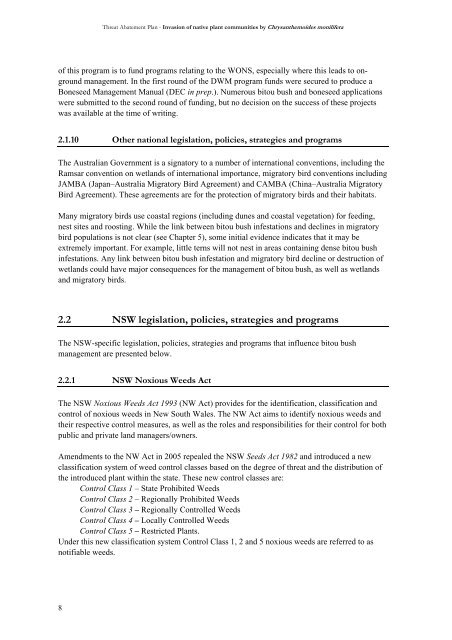NSW Bitou Bush Threat Abatement Plan - Department of ...
NSW Bitou Bush Threat Abatement Plan - Department of ...
NSW Bitou Bush Threat Abatement Plan - Department of ...
Create successful ePaper yourself
Turn your PDF publications into a flip-book with our unique Google optimized e-Paper software.
8<br />
<strong>Threat</strong> <strong>Abatement</strong> <strong>Plan</strong> - Invasion <strong>of</strong> native plant communities by Chrysanthemoides monilifera<br />
<strong>of</strong> this program is to fund programs relating to the WONS, especially where this leads to onground<br />
management. In the first round <strong>of</strong> the DWM program funds were secured to produce a<br />
Boneseed Management Manual (DEC in prep.). Numerous bitou bush and boneseed applications<br />
were submitted to the second round <strong>of</strong> funding, but no decision on the success <strong>of</strong> these projects<br />
was available at the time <strong>of</strong> writing.<br />
2.1.10 Other national legislation, policies, strategies and programs<br />
The Australian Government is a signatory to a number <strong>of</strong> international conventions, including the<br />
Ramsar convention on wetlands <strong>of</strong> international importance, migratory bird conventions including<br />
JAMBA (Japan–Australia Migratory Bird Agreement) and CAMBA (China–Australia Migratory<br />
Bird Agreement). These agreements are for the protection <strong>of</strong> migratory birds and their habitats.<br />
Many migratory birds use coastal regions (including dunes and coastal vegetation) for feeding,<br />
nest sites and roosting. While the link between bitou bush infestations and declines in migratory<br />
bird populations is not clear (see Chapter 5), some initial evidence indicates that it may be<br />
extremely important. For example, little terns will not nest in areas containing dense bitou bush<br />
infestations. Any link between bitou bush infestation and migratory bird decline or destruction <strong>of</strong><br />
wetlands could have major consequences for the management <strong>of</strong> bitou bush, as well as wetlands<br />
and migratory birds.<br />
2.2 <strong>NSW</strong> legislation, policies, strategies and programs<br />
The <strong>NSW</strong>-specific legislation, policies, strategies and programs that influence bitou bush<br />
management are presented below.<br />
2.2.1 <strong>NSW</strong> Noxious Weeds Act<br />
The <strong>NSW</strong> Noxious Weeds Act 1993 (NW Act) provides for the identification, classification and<br />
control <strong>of</strong> noxious weeds in New South Wales. The NW Act aims to identify noxious weeds and<br />
their respective control measures, as well as the roles and responsibilities for their control for both<br />
public and private land managers/owners.<br />
Amendments to the NW Act in 2005 repealed the <strong>NSW</strong> Seeds Act 1982 and introduced a new<br />
classification system <strong>of</strong> weed control classes based on the degree <strong>of</strong> threat and the distribution <strong>of</strong><br />
the introduced plant within the state. These new control classes are:<br />
Control Class 1 – State Prohibited Weeds<br />
Control Class 2 – Regionally Prohibited Weeds<br />
Control Class 3 – Regionally Controlled Weeds<br />
Control Class 4 – Locally Controlled Weeds<br />
Control Class 5 – Restricted <strong>Plan</strong>ts.<br />
Under this new classification system Control Class 1, 2 and 5 noxious weeds are referred to as<br />
notifiable weeds.
















